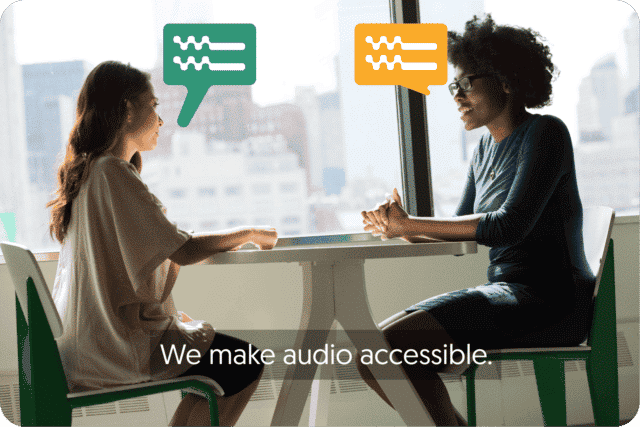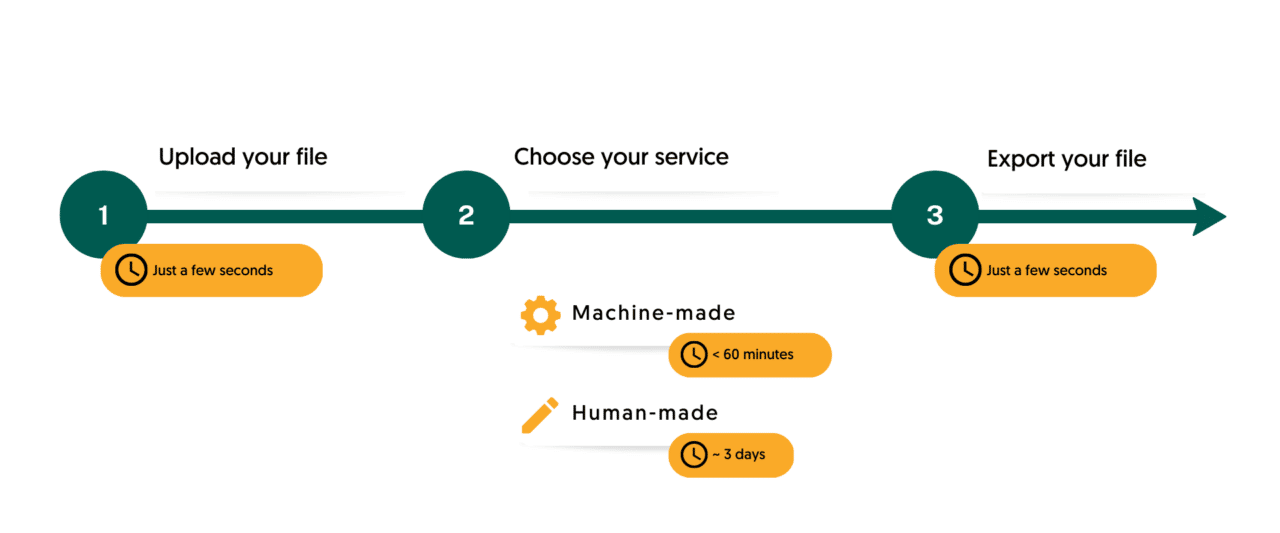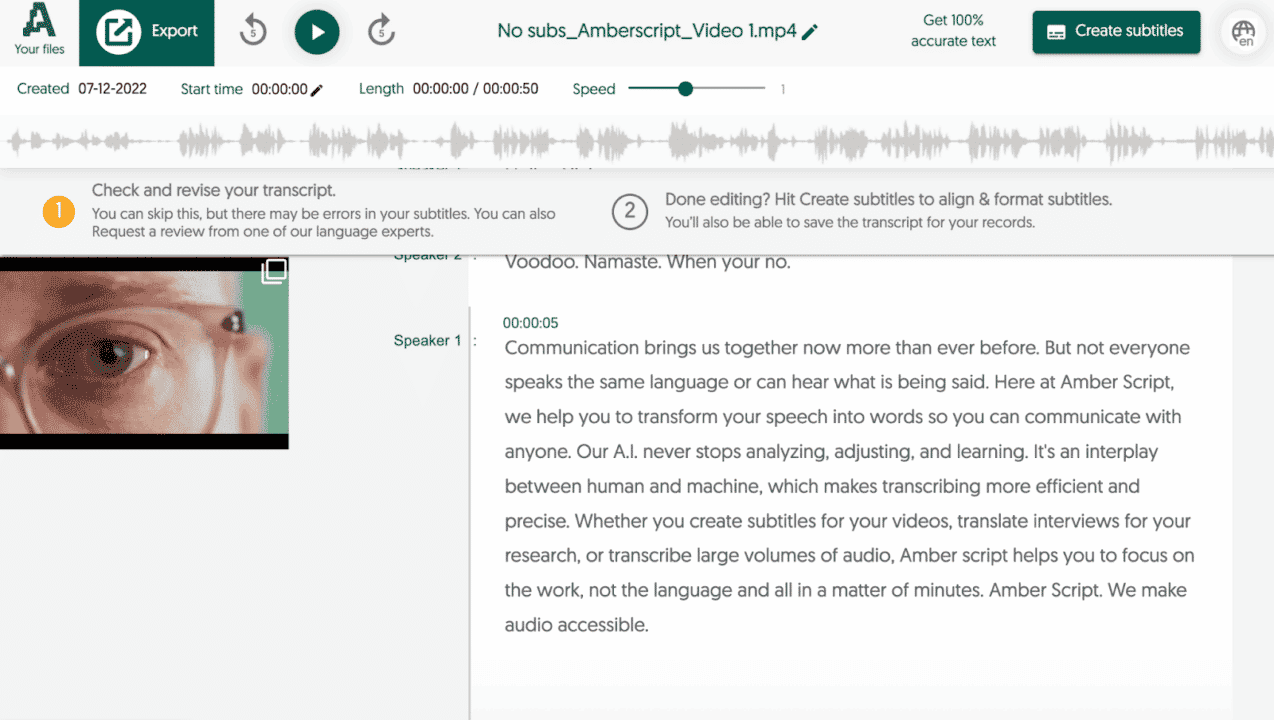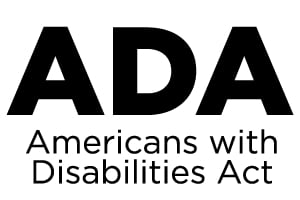Table of content
- What is Video Transcription & Why Do You Need It?
- Overview of Different Types of Video Transcription Services
- Different Types of Video File Format
- Benefits of Using Video Transcription Services for Different Industries
- Accuracy and Quality of Video Transcription
- Tips for Choosing the Right Video Transcription Service for your Needs
- How to Get Started with Video Transcription Services
What is Video Transcription & Why Do You Need It?
Video transcription is an essential process that involves converting spoken words from a video into written text. In simpler terms, it’s like taking the audio content of a video and turning it into words that can be read on paper. This process is important, and even crucial, for a variety of reasons, including accessibility, legislations, SEO, and engagement. Video transcription allows individuals who are deaf or hard of hearing to engage with video content and improves the user experience for everyone.
Transcriptions can be done in three different ways. Either manually by yourself, manually by a professional transcriber, freelancer, or transcription agency, or automatically using speech recognition software.

Request a quote
Legislation on Accessibility
Americans with Disabilities Act (ADA)
Ensuring accessibility is not just a legal requirement, but also a moral and ethical responsibility. It enables individuals with disabilities to fully participate in public life and have equal access to information and opportunities. By providing accessibility, entities can also expand their audience and reach a wider demographic, ultimately benefiting both themselves and their viewers.
Amberscript offers solutions for accessibility, including both machine-made and professional transcription services. Amberscript’s transcription services are designed to meet accessibility requirements and ensure compliance with the ADA and other accessibility regulations. With high accuracy and a user-friendly interface, Amberscript’s solutions can help entities create high-quality transcriptions that are accessible to all viewers.
Title II and Title III of ADA and their requirements for accessibility
The Americans with Disabilities Act (ADA) is a civil rights law that prohibits discrimination against individuals with disabilities in all areas of public life. Title II and Title III of the ADA require that public entities and places of public accommodation, respectively, provide equal access to individuals with disabilities, including those who are deaf or hard of hearing. Accessibility is an essential component of meeting this requirement.
Title II of the ADA applies to state and local government entities, including schools and universities, and requires them to provide effective communication for individuals with disabilities, which includes providing auxiliary aids and services such as closed captioning. Title III of the ADA applies to places of public accommodation, such as movie theatres and hotels, and also requires them to provide effective communication for individuals with disabilities, including through the provision of auxiliary aids and services.
Penalties for noncompliance with ADA
Penalties for noncompliance with the ADA can be severe, ranging from monetary fines to lawsuits and legal action. The U.S. Department of Justice is responsible for enforcing the ADA, and individuals can also file private lawsuits against noncompliant entities.
21st Century Communications and Video Accessibility Act (CVAA)
The 21st Century Communications and Video Accessibility Act (CVAA) was enacted by the Federal Communications Commission (FCC) in 2010 to ensure accessibility to modern communication technologies for people with disabilities. The act covers all video programming distributed over the internet, including live and prerecorded content.
- The CVAA requires video programming distributors to make their content accessible to individuals who are deaf, hard of hearing, blind, or visually impaired. This includes the provision of closed captions for pre-recorded and live programming, as well as audio descriptions for certain content.
- The CVAA requires video programming distributors to provide closed captions for all pre-recorded programming that has been shown on television with captions since September 30, 2012. For live programming, distributors must provide captions within 12 hours of the original airtime. The CVAA also requires video programming distributors to make their user interfaces accessible to people with disabilities.
- The FCC has the power to enforce the CVAA and impose penalties for noncompliance. Fines for noncompliance can range from $10,000 to $100,000 per violation. The FCC can also require distributors to take remedial actions to bring their services into compliance with the CVAA.
- In addition to the CVAA, the European Union has enacted several accessibility-related directives and regulations that cover accessibility. The European Accessibility Act (EAA) requires member states to ensure that goods and services, including video content, are accessible to people with disabilities. The Audiovisual Media Services Directive (AVMSD) requires on-demand audiovisual media services to provide access services such as transcription, audio description, and sign language interpretation.
Overall, the CVAA and other accessibility legislation underscore the importance of accessibility in ensuring equal access to information and entertainment for people with disabilities. It is important for video content producers and distributors to comply with these regulations and ensure that their content is accessible to all viewers. Amberscript can help by providing transcription services that meet the accessibility requirements of these laws and regulations.
Web Accessibility Directive
The Web Accessibility Directive is a piece of legislation introduced by the European Union in 2016. It aims to ensure that public sector websites and mobile applications are accessible to people with disabilities, including those with hearing impairments who require transcription to access audiovisual content. The directive requires all public sector bodies to make their websites and mobile applications accessible by complying with the Web Content Accessibility Guidelines (WCAG) 2.1, a set of guidelines for making content accessible on the web.
Overview of Different Types of Video Transcription Services
If you need to get a video transcribed, there are a few different transcription options available. It’s important to pick the right one based on your needs and goals. Two of the most common types of video transcription are verbatim and edited transcription.
Verbatim transcription means you transcribe every single word that’s spoken, including fillers like um’s and uh’s. It aims to record the way “how something is said”. During literal transcribing a letter-by-letter transcript is written out which the speakers follow as accurately and completely as possible.
This also means that interjections, repetitions, stutters, interrupting words, and colloquial language is literally typed out, such as:
| Interjections | Euhms and aahs |
| Repetitions | “I’m just saying, the region … the Brabant region uh, that uh, that’s the focus” |
| Stutters | “It’s mainly about the the the region in Brabant.” |
| Interrupted words | “We will be back to the municipal meeting next wee-, what is the name? City council meeting together” |
| Colloquial language | “Here we are all together” |
On the other hand, if you’re trying to get a video made for education or entertainment purposes, you might want to go with edited transcription instead. This involves taking out extra information like fillers and repetitions, which can help make your content more engaging and accessible. For example, if you’re making an educational video, edited transcription can give your students a more clear and concise summary of what’s covered in the video.
When you’re choosing which type of transcription to use, you’ll want to think about a few different things. First, what kind of industry are you in, and what are your goals? If you need accuracy and detail, verbatim might be your best bet. But if you want to be more engaging and concise, edited is probably the way to go. You should also think about how complicated your video is, and how you’re planning to use the transcription. Once you’ve thought about all of these factors, you’ll be able to choose the right type of transcription for your specific needs.
Transcribe with Amberscript in 3 simple steps

Benefits of Using Video Transcription Services for Different Industries
Media
Video transcription services can be incredibly beneficial for the media industry, particularly for creating closed captions and subtitles for video content which means you can make your content more accessible to a broader audience. Additionally, video transcription can help with SEO by providing searchable text that search engines can crawl. For instance, news organizations can use transcriptions to make their video content more searchable.
Education
If you’re in the education industry, you need to know about video transcription services! They’re especially useful for creating transcripts of online courses and lecture videos, making them accessible for everyone. Transcripts can be a lifesaver for students with hearing disabilities, language learners, and those who prefer to read instead of watch videos.
Transcripts can also be used for creating study materials and summaries. For example, a university can use video transcription to create transcripts of their online lectures for students to review later. By incorporating video transcription into your teaching, you’re taking an essential step towards making education inclusive for all!
Healthcare
Healthcare is one of the unusual industries that can benefit from video transcription. How? With transcripts on hand, healthcare professionals can easily and quickly find the information they need by streamlining their medical research recordings, patient consultations and medical training videos resulting in better communication and understanding between healthcare providers and patients.
Plus, video transcription makes it easy for hospitals to create training materials that are available to everyone, ensuring a consistent standard of care for all patients.
Filmmaking
Video transcriptions are a total game-changer for filmmakers but if you are already in the industry, you probably know it better than everyone! Transcript of your videos can help you dot every “i” and cross every “t” by creating precise scripts and subtitles. You can use transcripts to enhance your editing process and even target global audiences with more accuracy. Plus, video transcription shaves time off your production schedule because it allows you to easily search for specific content within your videos. Imagine how easy your life would be if making subtitles for films only took a few clicks! Thanks to Amberscript’s top-notch video transcription services, that’s now a reality.
Legal
As it is for many other sectors and industries, video transcription can be a game changer for the legal industry too! By creating accurate video transcripts of court proceedings, witness statements, and depositions, lawyers can effectively review and analyze evidence, prepare for cases, and ensure that important details are not missed. And that’s not all – video transcription can also help improve communication and understanding among legal professionals and clients. For instance, your law firm can use our video transcription service to create reliable transcripts of your court proceedings, squeeze it into the memo and ensure that everyone in your team has a crystal-clear picture of the case.
Accuracy and Quality of Transcription
The accuracy and quality of video transcription are critical factors that can have a significant impact on the usefulness and effectiveness of your transcribed content. While most video transcription software programs use advanced machine learning technologies to transcribe speech from videos, no transcription process is perfect, and errors and inaccuracies can occur. Poor audio quality, accents, and background noise can also make it more difficult for transcription software to accurately transcribe speech.
Challenges of Video Transcription
-
Background noise
Background noise can make it hard to hear the speakers or distinguish between different voices. To tackle this, it’s important to make sure that the audio recording is of good quality and to use noise-cancellation software or headphones to help reduce unwanted sounds. For example, a journalist conducting an interview in a busy coffee shop can use a directional microphone to pick up the interviewee’s voice and minimize background noise.
-
Strong accents
Strong accents can make certain words or phrases difficult to understand. A transcription service that offers language-specific models or employs transcribers who are familiar with the accent can be a big help. For instance, a podcaster interviewing a guest from another country with a thick accent can use a transcription service that has expertise in that language or accent.
-
Technical terminology
Technical terminology can also be a headache for transcriptionists, particularly in fields such as law or medicine. Providing the transcriber with a list of technical terms or using a transcription service that offers custom models for specific industries can help ensure accuracy. For example, a lawyer dictating legal briefs can use a transcription service that specializes in legal transcription and has a team of legal experts who are familiar with legal terminology.
To ensure the accuracy and quality of your video transcription, it’s important to choose a reputable and reliable transcription service provider or software. Additionally, it’s a good idea to review and edit your transcribed content carefully to ensure that it accurately reflects the spoken content in your video. It’s also important to consider your audience and the purpose of your transcription when reviewing and editing your content. For example, if your transcription is intended to be used as captions for a video, you’ll need to ensure that the text accurately conveys the spoken content in a concise and easy-to-read format.
Finally, it’s worth noting that the quality of your original video content can also impact the accuracy and quality of your transcription. High-quality video and audio equipment can help to minimize background noise and other distortions, resulting in clearer and more accurate transcriptions. By paying careful attention to the accuracy and quality of your video transcription, you can create high-quality, engaging content that resonates with your audience and achieves your goals.

Tips for Choosing the Right Video Transcription Service for Your Needs
Being on the market for a video transcription service can be a daunting task since there are so many different options available. Let’s take a look at on what you should be looking for when choosing the perfect video transcription service!
Accuracy and Reliability
Firstly, accuracy is essential. You want a transcription service that gets it right the first time, every time. At Amberscript, we use a combination of experienced transcribers and cutting-edge AI technology to ensure a high level of accuracy and fast turnaround times.
Confidentiality
Your videos may contain sensitive information that needs to be kept confidential. This is why it’s essential to choose a transcription service provider that takes your privacy seriously. Amberscript guarantees complete confidentiality, giving you peace of mind.

About our data security & privacy
Read moreTurnaround Times
Time is of the essence when it comes to video transcription. You don’t want to wait days or weeks for your transcripts. At Amberscript, we offer fast turnaround times, with the ability to receive your transcripts in as little as 24 hours.
Specialization
Different industries have different transcription needs. It’s important to choose a provider that specializes in your particular field to ensure that you receive accurate and relevant transcripts. At Amberscript, our transcription services are tailored to meet the specific requirements of a wide range of industries, including media, education, legal, healthcare, and many more!
Amberscript’s transcription services are:
Edit your text in minutes or leave the work to our experienced transcribers.
Our experienced transcribers and thorough quality controls ensure 100% accuracy of transcripts and subtitles.
Through a series of integrations and API interfaces, you can fully automate your workflows.
Your data is in safe hands. We are GDPR compliant + ISO27001 and ISO9001 certified.
Different Types of Video File Format
To transcribe a video file, you’ll need to use specialized video transcription software that is designed to accurately and efficiently transcribe speech from a video. This software uses advanced algorithms and machine learning technologies to analyze the audio content of your video and convert it into written text. Depending on the specific software you choose, you may also have access to additional features like automatic speaker identification, punctuation, and formatting tools that can help to streamline your transcription process.
When it comes to video file formats, there are a wide range of options to choose from, each with their own advantages and disadvantages. Some of the most common video file formats that can be transcribed include MP4, MOV, MV4, MPEG .. . Each of these formats has its own unique characteristics, such as file size, video quality, and compatibility with different playback devices and platforms. It’s important to choose a video file format that is compatible with your video transcription software and meets your specific needs and requirements for your video content.
Video file formats
-
MV4
This is a video container format developed by Apple, and quite similar to the MP4 format. Originally used in iTunes Store, as such files may be protected by DRM. Learn how to convert MV4 to text here.
-
MOV
QuickTime File Format that was originally used by QuickTime framework. It can contain multiple tracks, where each of them stores a different types of data: audio, video, or text. Learn how to convert MOV to text here.
-
MP4
It’s a MPEG-4 Part 14 digital multimedia container format that can store video, audio, and even subtitles, or still images. Learn how to convert MP4 to text here.
-
AVI
AVI is a video file format that was developed by Microsoft. It’s a widely supported file format for video transcription software and can be played on most devices. However, AVI files are often larger in size than other video file formats, which can make them slower to upload and share.
-
FLV
FLV is a video file format that was developed by Adobe. It’s commonly used for online video streaming and sharing, particularly for websites that use Flash Player. FLV files can be transcribed using video transcription software that supports the file format.
-
MPEG
This format was developed by The Moving Picture Experts Group and is used in various multimedia systems. There are multiple MPEG standards, but the most popular ones are MPEG-1, MPEG-2, and MPEG-4. Read how to convert your MPEG file to text.
How to Get Started with Video Transcription Services
In conclusion, video transcription is crucial for creating accurate and accessible content in today’s digital age. Amberscript offers high-quality transcription services tailored to the unique needs of our clients, with fast turnaround times, complete confidentiality, and a high level of accuracy.
Choose Amberscript as your video transcription service provider to receive the best possible service!
Frequently asked questions
-
Can I burn the subtitles directly onto my video?
If you have exported the transcript as a SRT, EBU-STL or VTT file, you can easily burn them onto your video using video-editing software.
-
Can I change the position of the subtitles?
That needs to be done using a video editor like VLC. Go to Tools > Preferences [CTRL + P]. Under Show settings, select the option that says All to switch to the advanced preferences. Navigate to Input/Codecs > Subtitle codecs > Subtitles. Under Text subtitle decoder set, the Subtitle justification to left, right or center.
-
How do I order translated subtitles?
To order translated subtitles, you can upload your file like you would normally do. You can then select manual subtitling. Once you have selected this, an option will appear where you will be able to select the language the subtitles need to be translated to. If the language that you want is not one of the options you can contact us through our contact form.
-
What subtitle file formats are supported?
Our software allows you to export the transcript from the video or audio file as an SRT, EBU-STL or VTT file.
-
How do I generate captions?
You can generate captions automatically using Amberscript. Our software allows you to export transcription based on audio/video files as SRT, EBU-STL or VTT files, which can easily be inserted into a video-editor. Want to know more? Here is a step-by-step guide.
-
How do you keep my files secure and confidential?
Amberscript’s IT infrastructure is built on the server infrastructure of Amazon Web Services located in Frankfurt, Germany. All data that is processed by Amberscript will be stored and processed on highly secured servers with regular back-ups on the same infrastructure.
-
In which formats can I export my subtitles?
Our software allows you to export the transcript from the video or audio file as an SRT, EBU-STL or VTT file.
-
What is the price?
For our prices, please refer to our pricing page.
-
What is the turnaround time?
Our state-of-the-art speech AI delivers results in less than an hour (depending on the size of the file, it can take only takes a few minutes). Just upload your audio into our system and we will notify you as soon as the file is ready! if you would like to learn about turnaround times for our manual subtitling services, click here.




